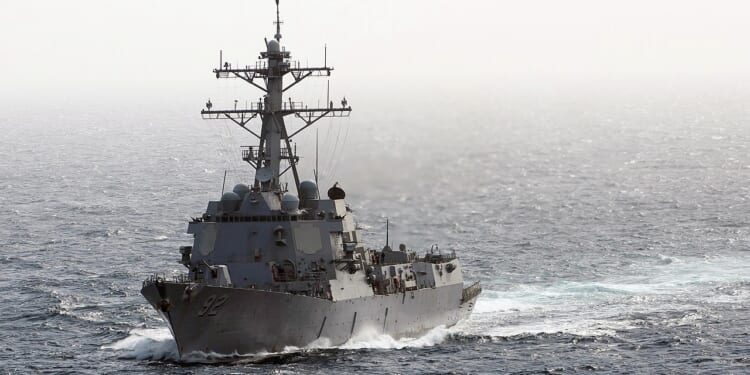The new destroyer is named for longtime Alaska senator Ted Stevens, a strong supporter of the US Navy and Marine Corps and an unintentional early Internet icon.
The United States Navy confirmed that the 78th Arleigh Burke-class guided-missile destroyer—and the third of its “Flight III” variant—has completed its second builder’s sea trials, a significant milestone in advance of its formal entry into service. The future USS Ted Stevens (DDG-128) is now on track to be commissioned next year.
The Arleigh Burke-Class Destroyer’s Specifications
- Year Introduced: 1991
- Number Built: 74
- Length: 505-510 ft, depending on variant
- Beam (Width): 66 ft
- Displacement: 9,000 tons
- Engines: Four General Electric LM2500 gas turbines (26,250 bhp each)
- Top Speed: ~30 knots (35 mph)
- Range: ~4,400 nmi (5,100 mi)
- Armaments: 5-inch Mk 45 gun; Harpoon anti-ship missiles; Aegis Combat System; Mk 45 or 46 torpedoes; Tomahawk cruise missiles (96 VLS cells)
- Crew: 303-323, depending on variant
Why Is the Flight III Destroyer So Different?
The Flight III variants, the fourth and most significant upgrades to the class, are equipped with the SPY-6(V)1 Air and Missile Defense Radar, the Aegis Baseline 10 combat system, and upgraded generators featuring a new 4,160-volt power grid to support the energy-intensive systems.
When DDG-128 enters service, it will be capable of carrying out a wide range of missions, including anti-air warfare (AAW), anti-surface warfare (ASuW), anti-submarine warfare (ASW), and ballistic missile defense.
The SPY-6(V)1 is the most advanced radar system yet deployed on the class of guided-missile destroyers. It was designed to provide enhanced threat detection and tracking capabilities for the US Navy’s surface combatants. It was developed by RTX subsidiary Raytheon, with support from the Navy and Johns Hopkins University’s Applied Physics Laboratory (APL). The radar features four array faces, each outfitted with 37 radar modules. That allows for continuous, 360-degree situational awareness.
The SPY-6 can defend against a variety of threats, including ballistic, cruise, and hypersonic missiles, as well as enemy aircraft and surface ships. According to RTX, it is able to respond to these threats simultaneously. It has increased detection range and sensitivity over legacy platforms, and “more accurate discrimination.”
Last month, Germany became the first international customer for the SPY-6, which will be installed on eight of its F127 frigates through a foreign military sales (FMS) contract with the United States Navy.
The Flight III Comes with Advanced Missile Systems, Too
The Aegis Baseline 10, the newest version of the US Navy’s Aegis Combat System, will further allow DDG-128 to protect naval fleets from advanced threats. It incorporates a variety of cutting-edge technologies, including artificial intelligence (AI) and machine learning, and can be integrated with air and missile defense platforms.
These improvements explain why the Flight III destroyers, including the future USS Ted Stevens, have a modified appearance from the earlier versions of the Arleigh Burke class.
This includes the addition of large enclosed extensions on the sides of the superstructure.
According to Maya Carlin, writing for The National Interest, “Block III’s bulky midsection was in part designed so that future upgrades could be incorporated into the destroyers. Electronic attack capabilities are critical as non-state actors and rogue entities across the seas are possessing more and more capable unmanned aerial vehicles (UAVs), anti-ship cruise missiles, and even ballistic missiles.”
The modified layout has been described as resembling a “muffin top.”
The USS Ted Stevens’ Commissioning Is Expected Next Year
DDG-128 was laid down in March 2022 and was named in honor of the late Senator Ted Stevens, the longest-serving senator from Alaska. Stevens was noted for his staunch support of the United States Navy and United States Marine Corps—but is probably best known in popular culture for once describing the Internet as “a series of tubes,” a widely-derided phrase that became one of the world’s earliest Internet memes.
The guided-missile destroyer will be commissioned next year in Alaska, likely in May or June. The commissioned ceremony will be part of a week-long celebration, according to Cherie Curry, a member of the USS Ted Stevens Commissioning Committee.
“We honor the crew during that week with block parties and receptions and breakfasts and crew events and sailors everywhere,” Curry told Alaska News Source in September.
As previously reported, the US Navy has requested a fleet of 75 mission-capable warships that can be rapidly deployed to hotspots around the world. DDG-128 could be one of those ships.
About the Author: Peter Suciu
Peter Suciu has contributed over 3,200 published pieces to more than four dozen magazines and websites over a 30-year career in journalism. He regularly writes about military hardware, firearms history, cybersecurity, politics, and international affairs. Peter is also a contributing writer for Forbes and Clearance Jobs. He is based in Michigan. You can follow him on Twitter: @PeterSuciu. You can email the author: [email protected].
Image: Wikimedia Commons.


















